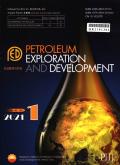Effects of phase-transition heat on fracture temperature in self-propping phase-transition fracturing technology
IF 8
Q1 ENERGY & FUELS
引用次数: 0
Abstract
The thermal flux curve of phase-transition fluid (PF) was tested using differential scanning calorimetry, based on which a reaction kinetics model was established to reflect the relationship between phase transition conversion rate, temperature and time. A temperature field model for fractures and rock matrix considering phase transition heat was then constructed, and its reliability was verified using previously established temperature field models. Additionally, the new model was used to study the effects of different injection parameters and phase-transition fracturing performance parameters on the temperature variations in fractures and matrix. The study indicates that, at different positions and times, the cooling effect of the injected cold fluid and the exothermic effect during the phase transition alternately dominate the temperature within the fracture. At the initial stage of fracturing fluid injection, the temperature within the fracture is high, and the phase transition rate is rapid, resulting in a significant impact of exothermic phase transition on the reservoir rock temperature. In the later stage of injection, the fracture temperature decreases, the phase transition exothermic rate slows, and the cooling effect of the fracturing fluid on the reservoir rock intensifies. Phase transition heat significantly affects the temperature of the fracture. Compared to cases where phase transition heat is not considered, when it is taken into account, the temperature within the fracture increases to varying degrees at the end of fluid injection. As the phase transition heat increases from 20 J/g to 60 J/g, the maximum temperature rise in the fracture increases from 2.1 °C to 6.2 °C. The phase transition heat and PF volume fraction are positively correlated with fracture temperature changes, while specific heat capacity is negatively correlated with temperature changes. With increasing injection time, the temperature and phase transition rate at the fracture opening gradually decrease, and the location of the maximum phase transition rate and temperature difference gradually shifts from the fracture opening to about 10 m from the opening.
自支撑相变压裂技术中相变热对裂缝温度的影响
采用差示扫描量热法测试了相变流体(PF)的热通量曲线,并在此基础上建立了反应动力学模型,以反映相变转化率与温度和时间的关系。建立了考虑相变热的裂缝和岩石基质温度场模型,并用已有的温度场模型验证了该模型的可靠性。此外,利用该模型研究了不同注入参数和压裂相变性能参数对裂缝和基质温度变化的影响。研究表明,在不同位置和时间,注入冷流体的冷却作用和相变过程中的放热作用交替主导着裂缝内的温度。注入压裂液初期,裂缝内温度高,相变速率快,放热相变对储层岩石温度影响显著。注入后期,裂缝温度降低,相变放热速率减慢,压裂液对储层岩石的冷却作用增强。相变热对断口温度有显著影响。与不考虑相变热的情况相比,当考虑相变热时,在流体注入结束时,裂缝内的温度有不同程度的升高。随着相变热从20 J/g增加到60 J/g,断口的最大温升从2.1℃增加到6.2℃。相变热和PF体积分数与断裂温度变化呈正相关,比热容与温度变化负相关。随着注入时间的增加,裂缝开口处的温度和相变速率逐渐降低,最大相变速率和温差的位置逐渐从裂缝开口向裂缝开口约10 m处移动。
本文章由计算机程序翻译,如有差异,请以英文原文为准。
求助全文
约1分钟内获得全文
求助全文

 求助内容:
求助内容: 应助结果提醒方式:
应助结果提醒方式:


